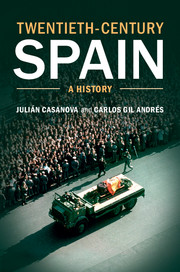Book contents
- Frontmatter
- Contents
- List of illustrations
- Key figures
- List of abbreviations
- Twentieth-century Spain timeline
- Maps
- Introduction
- Part I The monarchy of Alfonso XIII
- Part II The Second Republic
- Part III The Civil War
- Part IV Franco’s dictatorship
- Part V Transition and democracy
- 13 The Transition
- 14 Democracy
- Conclusion: the balance sheet of a century
- Guide to further reading
- Index of names and authors
- References
13 - The Transition
Published online by Cambridge University Press: 05 July 2014
- Frontmatter
- Contents
- List of illustrations
- Key figures
- List of abbreviations
- Twentieth-century Spain timeline
- Maps
- Introduction
- Part I The monarchy of Alfonso XIII
- Part II The Second Republic
- Part III The Civil War
- Part IV Franco’s dictatorship
- Part V Transition and democracy
- 13 The Transition
- 14 Democracy
- Conclusion: the balance sheet of a century
- Guide to further reading
- Index of names and authors
- References
Summary
On 20 November 1975, the date of Franco’s death, there was no script prepared, no pre-arranged path for an authoritarian dictatorship that had lasted almost four decades to turn peacefully into full democracy, recognised by every country in western Europe. Events followed their particular course but they could have been very different. The end result, at least from 1982 onwards, was a parliamentary monarchy based on a democratic constitution, with a large number of rights and freedoms, the consequence of a complex transition, riddled with conflicts, foreseen and unforeseen obstacles and problems, in the context of economic crisis and political uncertainty.
And all this occurred in barely seven years of history. In the first period, up to the 1977 general election, the political elites left over from Francoism went ahead with a legal reform of the institutions of the dictatorship, pushed from below by the forces of the democratic opposition and a broad social mobilisation of widely varying groups. A second phase was to run from the formation of a democratic parliament, with the power and willingness to draw up a constitution, until the approval of the text that had been agreed on among the main political parties in a referendum held in December 1978. Once the legal framework had been defined, the following years saw the beginning of the development of the rule of law and the organisation of autonomous territories amidst serious problems such as a military backlash, terrorism and the crisis of the party system. When the socialists came to power, following their landslide victory in October 1982, the Transition could be said to have concluded, and democracy was on the way to its consolidation.
- Type
- Chapter
- Information
- Twentieth-Century SpainA History, pp. 291 - 327Publisher: Cambridge University PressPrint publication year: 2014

